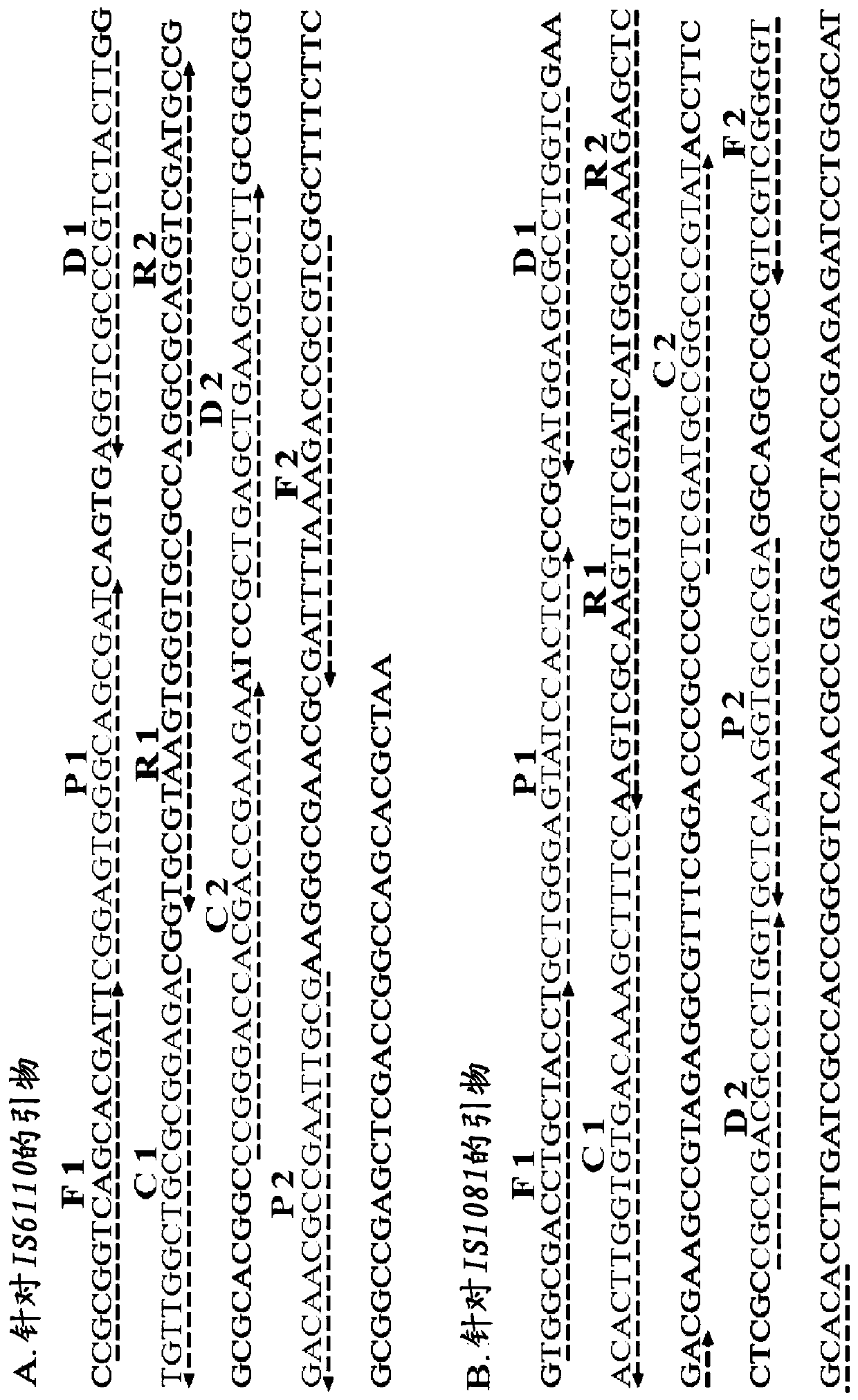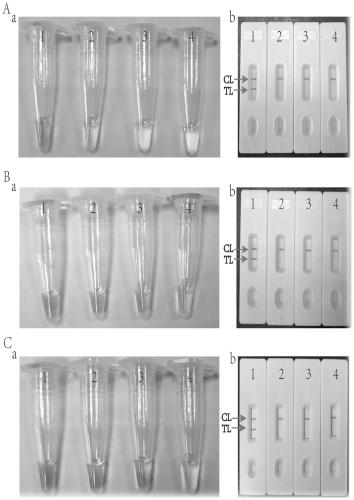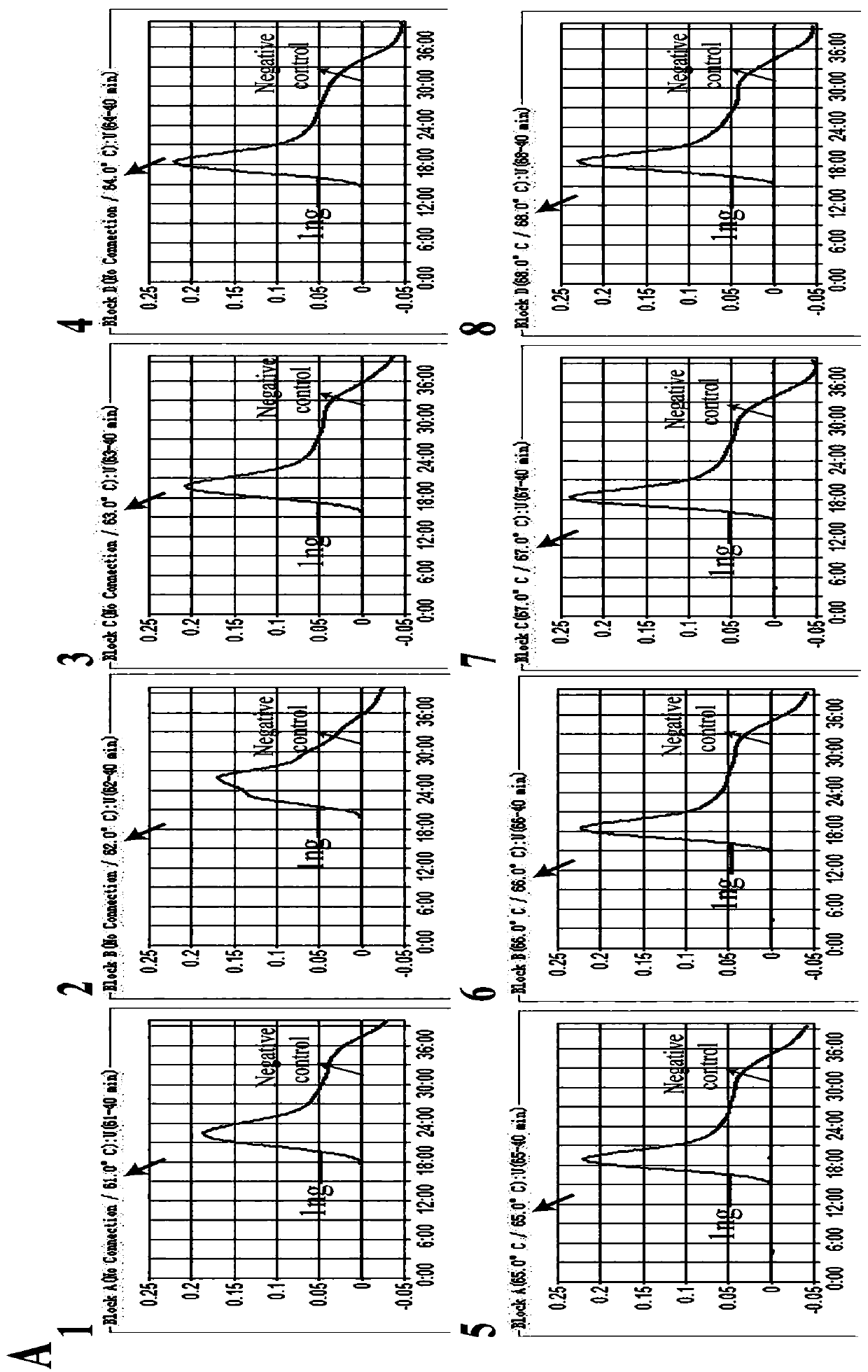Method for detecting mycobacterium tuberculosis complex through multi-crossover amplification and biosensing
A Mycobacterium tuberculosis, biosensing technology, applied in the field of microbiology, can solve the problems of expensive, difficult to judge the results, limit the promotion and application, etc., achieve high detection ability, high amplification specificity, and improve the effect of sensitivity
- Summary
- Abstract
- Description
- Claims
- Application Information
AI Technical Summary
Problems solved by technology
Method used
Image
Examples
Embodiment 1
[0051] The feasibility verification of embodiment 1.MCDA primer
[0052] MCDA amplification (see patent CN106544434A for details).
[0053] Standard MCDA reaction system (a set of primers): the concentration of the cross primer 6110-CP1, 6110-CP2 (or 1081-CP1, 1081-CP2) is 60 pmol, and the replacement primer 6110-F1, 6110-F2 (or 1081-F1, The concentration of 1081-F2) is 10pmol, the concentration of amplification primers 6110-R1, 6110-R2, 6110-D1, 6110-D2 (or 1081-R1, 1081-R2, 1081-D1 and 1081-D2) is 30pmol, The concentration of amplification primers 6110-C1*, 6110-C2 (or 1081-C1* and 1081-C2) is 20pmol, 10mM Betain, 6mM MgSO4, 1mM dNTP, 12.5μL of 10×Bst DNA polymerase buffer , 10U of strand-displacing DNA polymerase, 1 μL of template, add deionized water to 25 μl. The entire reaction was kept at 67°C for 1 hour, and the reaction was terminated at 85°C for 5 minutes.
[0054] Improved MCDA reaction system (two sets of primers): cross primers 6110-CP1, 6110-CP2, 1081-CP1 and ...
Embodiment 2
[0057] The optimal reaction temperature determination of embodiment 2.MCDA technology
[0058] Under standard reaction system conditions, the Mycobacterium tuberculosis DNA template and the designed MCDA primer (IS6110 or IS1081) were added respectively, and the template concentration was 1 ng / μL. The reaction was carried out under constant temperature conditions (61-68°C), and the results were detected by a real-time turbidimeter, and different dynamic curves were obtained at different temperatures, see Figure 3A with Figure 3B , Figure 3A Indicates for IS6110, Figure 3BIt shows the temperature dynamic curve of MCDA primers designed for IS1081 gene sequence to detect MTBC. 65-68°C (Figure 3A5-3A8, Figure 3B5-B8) is recommended as the optimal reaction temperature for MCDA primers of IS6110 or IS1081. In the subsequent verification of the present invention, 67° C. was selected as the constant temperature condition for MCDA amplification.
Embodiment 3
[0059] Embodiment 3.MCDA-LFB detects the sensitivity determination of MTBC
[0060] After serially diluted Mycobacterium tuberculosis DNA was used for MCDA amplification reaction, LFB detection showed: (1) The detection range of MCDA-LFB (IS6110) was 10 ng to 10 fg, and LFB appeared red lines in the TL and CL regions ( Figure 4 Aa1-Aa7 in ). When the amount of genomic template in the reaction system is reduced to below 10fg, LFB only appears a red line in the CL area, indicating a negative result ( Figure 4 Aa8 in ). Figure 4 Aa in Aa uses LFB to visualize and read MCDA amplification results; Figure 4 Aa1 to Aa8 in represent the template amounts of Mycobacterium tuberculosis are 10ng, 1ng, 100pg, 10pg, 1pg, 100fg, 10fg and 1fg, Figure 4 Aa9 in is the blank control (1 μL double distilled water). (2) The detection range of MCDA-LFB (IS1081) is 10ng ~ 100fg, and LFB appears red lines in the TL and CL areas ( Figure 4 Ba1-Ba6 in). When the amount of genomic template in...
PUM
 Login to View More
Login to View More Abstract
Description
Claims
Application Information
 Login to View More
Login to View More - R&D
- Intellectual Property
- Life Sciences
- Materials
- Tech Scout
- Unparalleled Data Quality
- Higher Quality Content
- 60% Fewer Hallucinations
Browse by: Latest US Patents, China's latest patents, Technical Efficacy Thesaurus, Application Domain, Technology Topic, Popular Technical Reports.
© 2025 PatSnap. All rights reserved.Legal|Privacy policy|Modern Slavery Act Transparency Statement|Sitemap|About US| Contact US: help@patsnap.com



